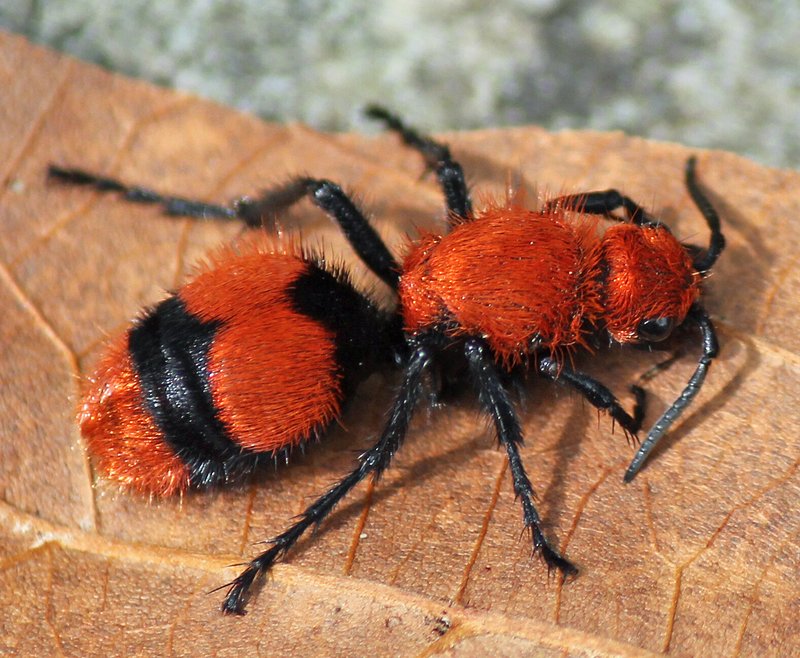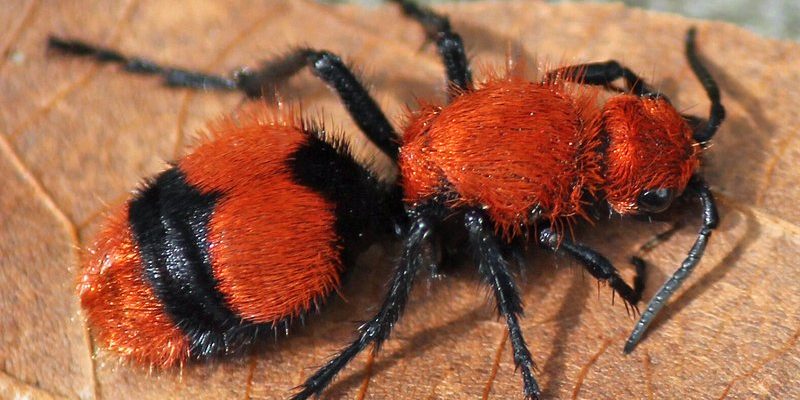
When you think of ants, you might picture a tiny black creature scurrying around your picnic. But the velvet ant is a different story altogether. These fascinating insects stand out with their vibrant colors and fuzzy appearance. Despite their name, they are not actually ants at all; they belong to the wasp family. Imagine a creature that looks like it’s dressed up for a party, yet it packs a fierce sting! That’s the velvet ant for you.
So, what’s the buzz about velvet ants? Well, these little wonders are more than just good looks. They have some unique traits that make them both intriguing and, let’s be honest, a little intimidating. If you ever encounter one in the wild, you’ll want to know what you’re dealing with. Grab a cup of coffee, and let’s dive into the world of velvet ants!
What Are Velvet Ants?
Velvet ants are actually a type of wasp, specifically belonging to the family Mutillidae. While they may resemble fuzzy ants, they are more closely related to bees and wasps. Their striking coloration ranges from bright orange and red to black, which serves as a warning to potential predators. Think of them as nature’s neon signs—”Look but don’t touch!”
These fascinating creatures can be found in many parts of the world, with a concentration in warm, dry habitats. You might spot them in sandy areas, grasslands, or even deserts, where they thrive in the sun. Velvet ants have a unique life cycle that starts as an egg laid in the nest of other wasps or bees. Once they hatch, the larva feed on the host’s larvae. It’s a tough life, but it’s how they’ve adapted to survive!
Physical Characteristics of Velvet Ants
One of the first things you’ll notice about velvet ants is their striking appearance. They’re often described as “furry” because of their dense, velvety hair that covers their bodies. This hair isn’t just for show; it helps to retain moisture and protects them from the sun. Their colors can range from vibrant red and orange to deep black, a feature that allows them to blend in with their surroundings while also warning predators about their sting.
Speaking of stings, velvet ants are notorious for their painful bites. The female velvet ant, in particular, possesses a powerful sting that has been rated as one of the most painful insect stings out there—comparable to the infamous bullet ant! When threatened, these females will unleash their sting, so it’s best to observe them from a distance. If you want to impress your friends, you can share that the velvet ant’s sting is so intense that it has its own ranking on the Schmidt Pain Index!
Habitat and Distribution
Velvet ants are widely distributed across various regions, predominantly thriving in warm climates. You can find them in sandy areas, scrublands, and grasslands, where they can easily blend into the environment. Their preferred home often includes areas that receive plenty of sunlight, as these insects thrive in warmth.
In North America, velvet ants are particularly prevalent in the southwestern United States, with species like the Cow Killer being a notable example. You might wonder how they manage to survive in such environments. Well, their ability to inhabit these sunny spots and their unique adaptations make them quite resilient. They can often be seen on the prowl during hot summer months, adding to their vibrant presence in nature.
| Characteristic | Details |
|---|---|
| Size: | Typically between 0.5 and 2 inches long. |
| Habitat: | Sandy areas, grasslands, and scrublands. |
| Diet: | Larvae of bees and wasps. |
| Coloration: | Bright orange, red, or black, often with a velvety texture. |
| Lifespan: | Varies by species, typically a few months as adults. |
| Reproduction: | Females lay eggs in the nests of other insects. |
| Sting: | Known for a very painful sting, rated high on the Schmidt Pain Index. |
Behavior and Life Cycle
The life cycle of a velvet ant is quite an interesting tale. It begins when a female lays her eggs in the nests of other bees or wasps. Once the eggs hatch, the larvae feed on the host larvae, which isn’t the most pleasant way to start life! However, it’s nature’s way of ensuring survival. After several weeks, the velvet ants mature into adults and emerge from the host nest, ready to take on the world.
Adult velvet ants are generally solitary creatures. They don’t form colonies like many other ant species. Instead, females go out searching for food and potential mates all on their own. They’re often seen wandering around during the day, basking in the sunlight and looking for opportunities to find a meal. In terms of food, they primarily feed on nectar and can sometimes be seen visiting flowers. This helps them gather energy while also playing a role in pollination, which is a nice benefit to the ecosystem.
How to Identify Velvet Ants
Identifying velvet ants isn’t too tricky once you know what to look for. Their most distinguishing feature is, of course, their vibrant color and fuzzy appearance. They have a stout, robust body, which is particularly noticeable in females. Males, on the other hand, tend to be less hairy and have wings, which can make them look a bit different.
When observing them in the wild, it’s essential to pay attention to their movement. Velvet ants tend to move quite deliberately and can often be seen crawling on the ground. If you spot one on a flower, take a moment to admire it from a distance. Remember, it’s best not to poke or prod them, as their sting can be very painful. So, while you’re enjoying their beauty, keep your distance!
Importance in the Ecosystem
Despite their fearsome reputation, velvet ants play a significant role in the ecosystem. As predators, they help manage the populations of other insects, particularly those within the nests they invade. By preying on the larvae of bees and wasps, they keep these populations in check, ensuring a balance in the ecosystem.
Additionally, velvet ants contribute to pollination while feeding on nectar. As they buzz around from flower to flower, they assist in the reproductive processes of various plants. This means they’re not just fierce little creatures; they’re also vital for supporting local flora, making them an integral part of their habitats.
Are Velvet Ants Dangerous?
While velvet ants can give quite the sting, they’re generally not dangerous to humans unless provoked. Their sting is often likened to that of a bee or wasp, but many who have experienced it describe it as exceptionally painful, lingering for hours. If you ever get stung, try to remain calm and treat it like any other insect sting—clean the area and apply a cold pack to reduce swelling.
It’s essential to remember that velvet ants won’t sting unless they feel threatened. So, if you see one, enjoy the sight and respect its space. With colorful patterns and unique buzz, they’re best admired from a distance, keeping in mind the golden rule of nature: “Look, but don’t touch!”
FAQ
What do velvet ants eat?
Velvet ants primarily feed on nectar from flowers, which gives them the energy they need to thrive. Interestingly, their larvae feed on the larvae of other insects, mainly bees and wasps, after the velvet ant lays its eggs in the host’s nest. This dual diet helps them survive through different life stages.
Where can I find velvet ants?
Velvet ants are often found in warm, dry habitats such as sandy areas, grasslands, and scrublands. In North America, they are most prevalent in the southwestern regions. You can spot them during the day, especially in the summer months, as they bask in the sun and search for food.
Are all velvet ants the same color?
No, velvet ants display a variety of colors. Some are bright orange or red, while others are black or a mix of both. This colorful appearance serves as a warning to potential predators about their painful sting. So while they’re visually stunning, they also send a message: “Stay away!”
Can velvet ants fly?
Only male velvet ants have wings and can fly. Females, which are flightless, are the ones you typically see scurrying on the ground. The presence of wings in males allows them to mate with the females and continue the species’ life cycle.
How do velvet ants reproduce?
Velvet ants reproduce by the female laying eggs in the nests of other insects, primarily bees and wasps. Once the eggs hatch, the larvae feed on the host’s larvae, eventually maturing into adult velvet ants. This unique reproductive strategy allows them to thrive in their environments.
What is the Schmidt Pain Index?
The Schmidt Pain Index is a scale created by entomologist Justin Schmidt to categorize the pain levels of insect stings. Velvet ant stings are rated high on this index, often compared to that of a bullet ant, known for its excruciating bite. Understanding the index helps highlight the various levels of discomfort associated with different insect stings.
How do velvet ants protect themselves?
Velvet ants rely on their striking colors and painful sting to deter predators. Their bright hues serve as warning signals, indicating that they are not safe to eat. If threatened, they will sting, which can be quite painful, ensuring that most potential predators think twice before approaching.
Do velvet ants have any predators?
While their painful sting helps keep most predators away, velvet ants can still fall victim to birds and some mammals that are able to tolerate their sting. However, their ability to blend into their surroundings with bright colors often helps them avoid detection in the wild.
How long do velvet ants live?
The lifespan of velvet ants varies by species, but adults typically live for a few months. Their life cycle includes several stages, from egg to larva to adult, and once they reach maturity, they have a short time to find food, mate, and reproduce before they perish.
Can velvet ants be kept as pets?
While it’s technically possible to keep velvet ants, they are not common pets due to their aggressive nature and painful sting. If you’re interested in observing them, it’s best to admire them in their natural habitat rather than attempting to keep them in captivity.

